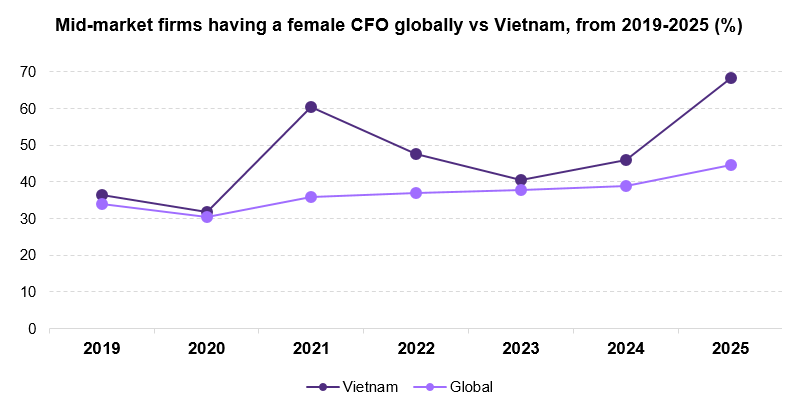CFO success

Grant Thornton International’s Women in Business (WIB) research, conducted as part of the International Business Report (IBR) survey, reveals a powerful milestone: 44.6% of mid-market businesses globally now have a female Chief Financial Officer (CFO) – a figure that’s nearing gender parity. This makes the CFO role the second senior leadership position to surpass the 40% mark, following HR director/officer which first reached this milestone in 2019.
In Vietnam, female CFOs are particularly prominent. Among surveyed mid-market businesses, 68.2% report a woman occupying the role, the highest share across all senior positions. This figure is also well above both global, ASEAN and Asia-Pacific averages.

It’s crucial to understand what’s driving progress in certain positions – and how these gains can be replicated across the C-suite.
The impact of global shifts on the CFO position
We see two key factors at play: firstly, the impact of macroeconomic events on the CFO role and secondly, the impact of increased female participation in education.
1. Macroeconomic motivators
The surge in female CFOs in the mid-market has coincided with a series of major macroeconomic disruptions. In the period following the 2008 financial crash, businesses have felt the impact of multiple shocks, from the Eurozone debt crises to China’s economic slowdown, and from the pandemic to surging energy prices following Russia’s invasion of Ukraine.
Our WIB research shows that the biggest increases in global CFO figures all align with crucial moments for the global economy. For example, in the years following Brexit, the global economy saw shifting trade agreements, new leadership in major economies, and the start of the #MeToo movement. This correlates with the data, where we have seen the percentage of women holding the CFO role increase by 15 percentage points from 2017 to 2019.
Vietnam’s experience suggests that macroeconomic events also seem to have influenced shifts in female CFO representation. Before COVID-19, the percentage of businesses having a female CFO was just above 30%. By 2021, the figure rose to 60%, then generally ranged between 40% and 50% in subsequent years, before reaching a new high of 68.2% in 2025. This latest increase comes as Vietnam has been making efforts to recover its economy amid global headwinds since 2023, which may have led some mid-market firms to adjust their leadership structures, particularly in financial management aspects to stay resilient and maintain operations.

2. Education participation – growing the talent pool
The rise in the number of women in senior management has followed rapid growth in female participation in tertiary education. Consequently, more women now have advanced qualifications, which are particularly important for senior financial positions such as CFO.
According to the Association to Advance Collegiate Schools of Business (AACSB), female enrolments in finance master’s degrees in the US rose 41% year-on-year in 2021/22, and 70% year-on-year in the rest of the world.
In Vietnam, where 68.2% of CFOs are women, women now account for 54% of tertiary education graduates. We found this to be a common factor across other countries where women dominate the CFO role.
The message is clear: Mid-market businesses need to continue to bridge the gap between education and leadership, ensuring women have clear pathways from the classroom to the boardroom.
Catalyst for change - pull up and step up
The increase in female CFOs is not only good news for that particular position, but it’s a launchpad for broader change. Higher levels of female CFOs can be a catalyst for increasing the number of women in other senior management positions. They can ‘pull up’ other women, supporting or mentoring them to fulfil their potential, helping them rise through the ranks to senior and board level roles.
Female CFOs are also well positioned to ‘step up’ into the Chief Executive Officer (CEO) position, where women’s levels of participation remain stubbornly low (21.7%, globally). The CFO-to-CEO transition is a well-trodden path, with 40% of all global CEOs stepping into the role directly from being either a CFO, COO, or head of division. This increase in CFO numbers could therefore help shift this balance.

Ripples throughout the C-suite
A strong female presence at the CFO level can challenge boardroom biases, influence governance practices, and foster a culture where women thrive in senior roles. The rise of female CFOs shows what’s possible and what could be next. The task now is to convert this momentum into wider change, ensuring more women step into other board-level positions so that gender diversity becomes embedded across the entire leadership spectrum.

Contact us
